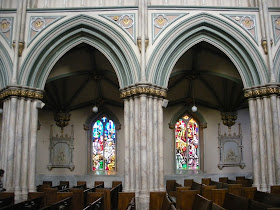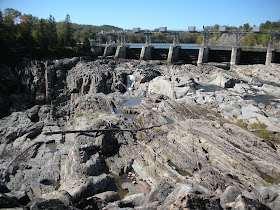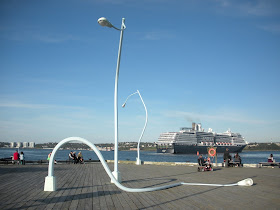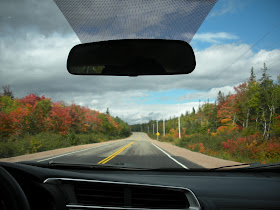This space is turning into a bit of a travel blog. I promise I do still have a job -- vacations just happen to be more interesting to write about.
Right now I'm halfway through a two-week family trip to eastern Canada. We're finishing up in the Maritimes and heading into Quebec tomorrow. Here's my journaling on what we've seen so far (and I apologize for the length!):
Day 1: Kingston, ON
Shout out to A & A for being wonderfully hospitable hosts and tour guides at our starting point, lovely Kingston, Ontario :)
Day 2: Rivière-du-Loup, QC
This morning we drove east from Kingston into Quebec along the south shore of the St. Lawrence River. This is a very pretty area, with lots of riverside villages. We stopped at a few:
Saint-Michel-de-Bellechasse is a cute town with a general store, well-kept old houses, and a large waterfront park.
Saint-Pacôme is in a beautiful river valley, with emerging autumn colours.
Kamouraska was probably our favourite town. With character houses, cafés, and art galleries overlooking the river, it seemed like an interesting yet relaxed place to live.
Notre-Dame-du-Portage is also very pretty; we checked out the waterfront church and rocky beach.
In the early evening we arrived at Rivière-du-Loup, a slightly larger town where we're spending the night at Auberge de la Pointe. We were just in time for sunset -- and were lucky enough to be upgraded to a room with a view.
Day 3: Saint John, NB
We spent this crisp sunny morning driving through autumn-hued hills into New Brunswick.
Our first stop was at Grand Falls, a town built around a wide rocky gorge on the Saint John River. The falls aren't very big this time of year, but from the photos in the visitors' centre we could see that they do become pretty impressive in the spring.
We stopped for a picnic lunch at Hartland, a little town famed for having the world's longest covered bridge (391 m / 1282 ft). Built in 1901, it can only accommodate single-lane traffic, which is a little dicey because there is no traffic control. You've just got to make sure there's no one coming from the other side before heading in!
We headed south to Fredericton, New Brunswick's capital, a small city along the Saint John River. Fredericton has lots of beautiful old houses, grand despite peeling paint and warped window panes. We walked through the historic Garrison District, toured the Legislative Building, and checked out the lovely stained glass of Christ Church Cathedral (1853).
 |
| soldiers' barracks in the Garrison District |
 |
| self-supporting spiral staircase from the 1880s at the Legislature |
 |
| Christ Church Cathedral |
We continued south to Saint John, a port city on the Bay of Fundy. It is one of Canada's oldest cities and definitely feels like a step back in time. We walked past the downtown's restored facades, and through some nearby residential areas that looked a little less gentrified.
Day 4: Bridgewater, NS
We left a foggy Saint John this morning to visit Rothesay, the next town over in a pretty deciduous river valley. We stopped to walk around the campus of Rothesay Netherwood School, a beautiful independent boarding school where my parents taught and lived in the late '80s.
We continued on to Fundy National Park, a large forested space along the Bay of Fundy. The park is full of great hiking trails. We walked the Dickson Falls Trail, a short but pretty loop down to a stream and little waterfall.
On the eastern border of the park is Alma, a tiny fishing village. We stopped at Collins Lobster Shop for a seaside picnic.
We refueled in Moncton, then headed to Fort Beauséjour, a battle fort built by the French in 1751, and later overtaken by the British. It's now a Parks Canada National Historic Site (free for Canada 150!). Although the visitors' centre is closed for the season, we had the fort all to ourselves on this midweek afternoon. We walked atop the hills comprising the fort's walls, then checked out the stone ruins within.
We crossed into Nova Scotia, skirted Truro, and continued on to the town of Bridgewater, on the province's south coast. We're staying in an Airbnb here in a beautifully renovated 100-year-old house.
Day 5: Dartmouth, NS
We left Bridgewater this morning to drive the scenic Lighthouse Route to Halifax along Nova Scotia's south shore. Our first stop was at Lunenberg, a port town that's home to the Bluenose II (absent today). We walked around the UNESCO World Heritage Site historic downtown, taking in the cute colourful facades of shops and eateries.
We made our way east through more nice little fishing villages: Blue Rocks, Mahone Bay (with scarecrow festival in full swing), Chester, Indian Harbour, and Peggy's Cove, and countless others in-between.
 |
| Blue Rocks |
 |
| Mahone Bay |
 |
| Cleveland Beach Provincial Park |
Peggy's Cove is as sweet as you'd imagine, a small village of colourful houses, interspersed with dinghies and stacks of lobster traps.
We walked out onto the rocky shore to see the iconic lighthouse, which dates back to 1914. You can't go inside, but we spent our time like the hundred other visitors, scrambling over the granite and watching the waves roll in (from a safe distance! there was no shortage of warnings).
We arrived in Halifax in the late afternoon and headed straight for the Citadel, a large stone fort on a hill overlooking downtown. It's free to enter this year (Canada 150), so we spent some time wandering around the big courtyard, walking atop the wall, and perusing the Army Museum.
We spent the rest of the afternoon walking along the docks and through some of the historic downtown.
At sunset we headed across the bridge to Dartmouth, where we'll be staying tonight.
Day 6: Baddeck, NS
Today we continued east along Nova Scotia's south shore, a very pretty region with beaches, little villages, and the nicest fall colours we've seen yet.
 |
| Lochiel Lake Provincial Park |
We crossed a causeway to Cape Breton Island and made our way to Baddeck, a little town on the shore of Bras d'Or Lake. We're staying at Ceilidh Country Lodge here, a cute place across from the lake.
 |
| view from our room |
Baddeck is touristy for its size, thanks to its most famous resident, Alexander ("Alec") Graham Bell, who lived at his estate Beinn Bhreagh from 1886 to 1922.
 |
| scarecrow Alec and his wife Mabel |
We spent the afternoon at the Alexander Graham Bell National Historic Site, a nicely assembled museum that's free this year to visit.
 |
| beautiful grounds |
We found it fascinating to learn about Alec's many interests. Although best known for his invention of the telephone, he dappled in everything from sheep breeding to x-rays. Many of his inventions are on display, including a replica of his plane, the Silver Dart, and what remains of his hydrofoil, the HD-4, the fastest watercraft in the world in its day. Alec's wife Mabel was also very bright and accomplished, despite being deaf.
 |
| Silver Dart and HD-4 |
 |
| cross-section of what remains of the hull of HD-4 |
We had a nice dinner of local mussels (from Baddeck Lobster Suppers), biscuits, and salad, then took a walk along the waterfront to enjoy a pretty sunset from muskoka chairs.
Day 7: Louisbourg, NS
We headed out from Baddeck this morning onto the Cabot Trail, a coastal road that circumnavigates part of Cape Breton Island. We set out counter-clockwise around the loop, passing along rugged coastlines and through occasional small villages. The mixed deciduous/coniferous forests make for a patchwork backdrop at this time of year.
The road passes through Cape Breton Highlands National Park, which boasts pretty spectacular landscapes, varying from a vast plateau to mountains and valleys to sandy coves. We stopped for walks along a bog boardwalk and a west coast beach covered in beautiful flat rocks.
We continued east around Sydney to Louisbourg, checked into a little trailer house, and picked up haddock fish and chips from a red school bus-turned-Chip Wagon for dinner.
Day 8: Stellarton, NS
This morning we headed a little ways outside of town to visit the Fortress of Louisbourg, a fortified village on the shore. The Fortress was built by the French between 1720 and 1740 to defend against the British. It saw two battles, in 1745 and 1758, which the British won. The Fortress was designated a National Historic Site in the 1920s and 25% of the structures were painstakingly reconstructed in the 1960s and 70s to create the living museum that operates today.
We spent close to 4 hours walking around the site and poking around in the buildings that were open, historically furnished or housing displays. Owing to it being late in the season, we encountered just a handful of historic interpreters; their presence and commentary nonetheless really added to the visit.
We continued from Louisbourg along the south shore of Bras d'Or Lake, through Port Hawkesbury and Antigonish to Stellarton, a little town where we're spending the night near to the PEI ferry terminal.
Day 9: New London, PEI
This morning we were up early for a 75-minute Northumberland ferry ride from Caribou, Nova Scotia, to Wood Islands, Prince Edward Island. Fun fact: travel to PEI via ferry or bridge is free; you pay on the way back to the mainland.
We drove through red clay countryside to Charlottetown, the "Birthplace of Confederation". Despite being the largest city on the Island, Charlottetown feels quite small-town. The harbourfront downtown is quaint, with colourful old buildings housing gift shops and restaurants.
 |
| Charlottetown things: Sir John A. MacDonald and an Anne of Green Gables gift shop |
Province House, the site of the Charlottetown Conference in 1864, the first of several meetings to discuss union of the provinces, now serves as the legislative building and is closed for renovations. We instead headed next door to the Confederation Centre of the Arts to learn a bit more about the political history, as well as peruse an art gallery.
 |
| Province House, mid reno |
 |
| a replica of the Charlottetown Conference setting |
 |
| Confederation Centre Art Gallery |
 |
| LM Montgomery's original Anne of Green Gables manuscript on display at the art gallery |
 |
| we also took a look inside St. Dunstan's Basilica in downtown Charlottetown -- beautiful stained glass |
We next headed up to the north coast to see Prince Edward Island National Park, a beautiful expanse of sandy beaches, dunes, and red sandstone.
We continued west along the shore to the town of Cavendish, the setting that inspired Lucy Maud Montgomery's Anne of Green Gables. The Green Gables house, a National Historic Site, is an 1800s farmhouse owned by the MacNeill family, cousins of LM Montgomery who lived nearby with her grandparents. She frequently visited the home and based the fictional Green Gables, Haunted Woods, Lovers' Lane, and Balsam Hollow on the house and surrounding areas.
 |
| Haunted Woods |
 |
| Lovers' Lane |
In spite of the busloads of tourists, we could appreciate how the idyllic setting inspired that of the novel. Walking through the old farmhouse, carefully decorated to reflect the novel, it at times felt as though Anne was a real character. It was very neat to see fiction come to life, gaining not only the recognition of Parks Canada, but visitors from around the world.
 |
| everything Anne |
We took an afternoon walk along a very windy Cavendish Beach. At this time of year the area is a ghost beach-town, with restaurants, souvenir shops, cottages, and an amusement park all closed for the season.
We pulled into New London, birthplace of LM Montgomery, and checked into the Bay Motel as the winds picked up outside.
 |
| LM Montgomery's birth house, now a museum (we didn't go in) |
 |
| potato field views from our hotel room |
Day 10: Bouctouche, NB
We headed out from New London this morning onto the North Cape Coastal Drive. We didn't do the full loop, but saw plenty of Acadian villages, potato harvests, red clay roads, lagoons, and beaches.
 |
| very pretty foliage here |
 |
| red roads and potato harvesting |
We crossed the 13-km-long Confederation Bridge over Northumberland Strait to New Brunswick. It's a really nice bridge, but the open-water views weren't particularly exciting after several days of driving along coastlines.
We drove through the countryside, stopped in Cocagne at the only open grocery store we'd seen all day (Thanksgiving), and pulled into Bouctouche mid-afternoon. Bouctouche is a small seaside town near Kouchibouguac National Park, where we're headed tomorrow. We happened upon lobster and poutine at Pirate de la Mer, a simple seafood restaurant near our hotel, for a memorable Thanksgiving dinner.
--
If you've made it this far and by chance are still interested, I'll post the rest of our trip when I get home next week!

































































































Looks amazing! I did part of this a couple years ago with my family and it was so nice to look at your pictures and think "Oh yeah, I've been there" :) I especially liked PEI, Lunenburg and Fredericton. Can't wait to hear about the rest of the trip!
ReplyDeleteOh neat! Those were some of my favourite places as well, especially Lunenberg. I'll try to get caught up on posting this weekend!
Delete